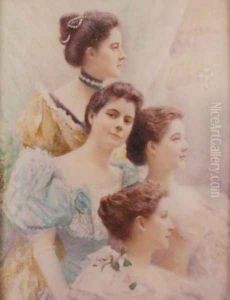Carl and Frederika Weidner Paintings
Carl Weidner and Frederika Weidner were a notable pair in the American art scene, particularly known for their contributions in the late 19th and early 20th centuries. Carl, born in 1863, and Frederika, born in 1860, were not just partners in life but also in their artistic pursuits, often inspiring and influencing each other's work.
Carl Weidner was recognized for his exceptional skills in etching, watercolor, and teaching. He studied in Europe, a common practice among American artists of his time who sought the classical art training available there. Upon returning to the United States, Carl became a significant figure in the art communities of New York and Philadelphia. His works were celebrated for their intricate details and the ability to capture the essence of his subjects, ranging from urban landscapes to serene natural scenes.
Frederika Weidner, on the other hand, was known for her delicate watercolors and oil paintings. Her subjects often included still lifes and landscapes, marked by a subtle use of color and light. Frederika's work, although not as widely recognized as her husband's during their lifetimes, has gained appreciation for its contribution to the American Impressionist movement. Her ability to infuse everyday scenes with vibrancy and emotion speaks to her keen observation and technical prowess.
Together, Carl and Frederika Weidner contributed to the American art scene through their participation in exhibitions, associations, and teaching. They were members of various art organizations and their works were exhibited in numerous galleries across the United States. Despite the differences in their subject matter and style, the Weidners shared a commitment to their art and to each other, influencing the artistic community with their dedication and passion.
Carl's career was also marked by his commitment to art education. He taught at several institutions, sharing his knowledge and skills with the next generation of artists. This aspect of his career reflects the broader movement of the time, which emphasized the importance of formal art education and mentorship in the development of American art.
Frederika's death in 1932 marked the end of a partnership that had significantly contributed to the enriching of their mutual artistic endeavors. Carl continued his work until his death in 1945, leaving behind a legacy that included not only his own artworks but also the many students he inspired. The Weidners' lives and work remain a testament to the dynamic and evolving nature of American art during their time.
